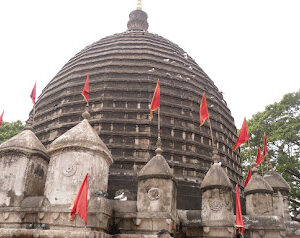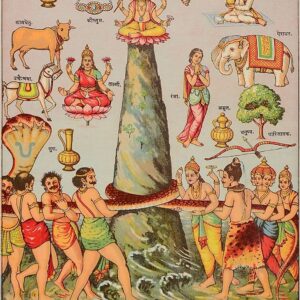The Shree Padmanabhaswamy Temple is a Hindu temple, dedicated to Maha Vishnu, in Thiruvananthapuram, the capital of the state of Kerala, India. It is widely considered as the world’s richest Hindu temple.The name of the city of ‘Thiruvananthapuram’ in Malayalam and Tamil translates to “The City of Ananta” (Ananta being a form of Vishnu). The temple is built in an intricate fusion of the Kerala style and the Dravidian style of architecture, featuring high walls, and a 16th-century gopura. While as per some traditions the Ananthapura temple in Kumbla in Kasaragod district in Kerala is considered as the original spiritual seat of the deity (“Moolasthanam”), architecturally to some extent, the temple is a replica of the Adikesava Perumal temple in Thiruvattar in Kanyakumari district in Tamil Nadu.
The principal deity is Padmanabhaswamy (Vishnu), who is enshrined in the “Anantha Shayana” posture, the eternal yogic sleep on the infinite serpent Adi Shesha. Padmanabhaswamy is the tutelary deity of the Travancore royal family. The titular Maharaja of Travancore, Moolam Thirunal Rama Varma, is the current trustee of the temple.
History
Gopuram of the Padmanabhaswamy Temple
Several extant Hindu texts including the Vishnu Purana, Brahma Purana, Matsya Purana, Varaha Purana, Skanda Purana, Padma Purana, Vayu Purana and Bhagavata Purana mention the Padmanabhaswamy Temple. The Temple has been referred to in the (only recorded) Sangam period literature several times. Many conventional historians and scholars are of the opinion that one of the names that the Temple had, “The Golden Temple”, was in cognisance of the Temple being already unimaginably wealthy by that point (early Sangam period). Many extant pieces of Sangam Tamil literature and poetry as well as later works of the 9th century of Tamil poet–saints like Nammalwar refer to the temple and the city as having walls of pure gold. Both the temple and the entire city are often eulogised as being made of gold, and the temple as heaven.
The temple is one of the 108 principal Divya Desams (“Holy Abodes”) in Vaishnavism according to existing Tamil hymns from the seventh and eighth centuries C.E and is glorified in the Divya Prabandha. The Divya Prabandha glorifies this shrine as being among the 13 Divya Desam in Malai Nadu (corresponding to present-day Kerala with Kanyakumari District). The 8th century Tamil poet Alvar Nammalvar sang the glories of Padmanabha.
It is believed that Parasurama purified and venerated the idol of Sree Padmanabhaswamy in Dvapara Yuga. Parasurama entrusted ‘Kshethra karyam’ (Administration of the Temple) with seven Potti families – Koopakkara Potti, Vanchiyoor Athiyara Potti, Kollur Athiyara Potti, Muttavila Potti, Karuva Potti, Neythasseri Potti and Sreekaryathu Potti. King Adithya Vikrama of Vanchi (Venad) was directed by Parasurama to do ‘Paripalanam’ (Protection) of the Temple. Parasurama gave the Tantram of the Temple to Tharananallur Namboothiripad. This legend is narrated in detail in the Kerala Mahathmyam which forms part of the Brahmanda Puranam.
Another version regarding the consecration of the principal idol of the Temple relates to the legendary sage Vilvamangalathu Swamiyar. Swamiyar, who resided near Ananthapuram Temple in Kasaragod District, prayed to Vishnu for his darshan or “auspicious sight”. The deity is believed to have come in the guise of a little boy who was mischievous. The boy defiled the idol which was kept for puja. The sage became enraged at this and chased away the boy who disappeared before him. Realising the boy was no ordinary mortal, the sage wept for forgiveness and asked for another darshan as a sign. He heard a voice say “If you want to see me come to the Anathavana (the unending forest or Ananthakadu). After a long search, when he was walking on the banks of the Laccadive Sea, he heard a pulaya lady warning her child that she would throw him in Ananthankadu. The moment the Swami heard the word Ananthankadu he was delighted. He proceeded to Ananthankadu based on the directions of the lady of whom he enquired. The sage reached Ananthankadu searching for the boy. There he saw the boy merging into an iluppa tree (Indian butter tree). The tree fell down and became Anantha Sayana Moorti (Vishnu reclining on the celestial snake Anantha). But the edifice that the deity assumed was of an extraordinarily large size, with His head at Thiruvattar near Thuckalay, Tamil Nadu, body or udal at Thiruvananthapuram, and lotus-feet at Thrippadapuram near Kulathoor and Technopark (Thrippappur), making him some eight miles in length. The sage requested the deity to shrink to a smaller proportion that would be thrice the length of his staff. Immediately the deity shrank to the form of the idol that is seen at present in the Temple. But even then many iluppa trees obstructed a complete vision of the deity. The sage saw the deity in three parts – thirumukham, thiruvudal and thrippadam. The swami prayed to Padmanabha to be forgiven. He offered rice kanji and uppumanga (salted mango pieces) in a coconut shell to the Perumal which he obtained from the pulaya woman. The spot where the Sage had darsan of the deity belonged to Koopakkara Potti and Karuva Potti. With the assistance of the reigning King and some Brahmin households a temple was constructed. The Ananthankadu Nagaraja Temple still exists to the northwest of the Padmanabhaswamy Temple. The samadhi (final resting place) of the swamiyar exists to the west of the Padmanabhaswamy Temple. A Krishna temple was built over the samadhi. This temple, known as Vilvamangalam Sri Krishna Swami Temple, belongs to Thrissur Naduvil Madhom.
Mukilan, a Muslim marauder, invaded vast chunks of Venad in 1680 AD. He destroyed Budhapuram Bhaktadasa Perumal Temple owned by Neythasseri Potti. Mukilan had plans to plunder the vaults of Sree Padmanabhaswamy Temple and destroy it. But he was dissuaded from doing so by local Muslims loyal to the royals of Venad. Padmanabhan Thampi, arch rival of Anizhom Thirunal Marthanda Varma, marched to Thiruvananthapuram with his forces and tried to loot the vaults of the Temple. Thampi stayed at Sri Varaham and sent his mercenaries to Sree Padmanabhaswamy Temple. It is said that divine serpents materialised in hundreds and scared away Thampi’s men. Emboldened by this heavenly intervention, Pallichal Pillai and local people opposed Padmanabhan Thampi and ensured that the mercenaries did not proceed with the misadventure.
Travancore royal family
In the first half of the 18th century, in line with matrilineal customs, Anizham Thirunal Marthanda Varma, succeeded his uncle Rama Varma as king at the age of 23. He successfully suppressed the 700-year-old stranglehold of the Ettuveetil Pillamar (“Lords of the Eight Houses”) and his cousins following the discovery of conspiracies which the lords were involved in against the royal house of Travancore (There are various legends and disputes about these mostly apocryphal stories, but overall, he took control and centralised the rule). The last major renovation of the Padmanabhaswamy temple commenced immediately after Anizham Thirunal’s accession to the throne and the idol was reconsecrated in 906 ME (1731 CE). On 17 January 1750, Anizham Thirunal surrendered the Kingdom of Travancore to Padmanabhaswamy, the main deity at the temple, and pledged that he and his descendants would be vassals or agents of the deity who would serve the kingdom as Padmanabha Dasa. Since then, the name of every Travancore king was preceded by the title ‘Sree Padmanabha Dasa’; the female members of the royal family were called ‘Sree Padmanabha Sevinis’ both meaning the servant to Padmanabhaswamy; . The donation of the king to Padmanabhaswamy was known as Thrippadi-danam. The final wishes of Anizham Thirunal on his passing at the age of 53 clearly delineated the historical relationship between the Maharaja and the temple: “That no deviation whatsoever should be made in regard to the dedication of the kingdom to Padmanabhaswamy and that all future territorial acquisitions should be made over to the Devaswom.”
















Reviews
There are no reviews yet